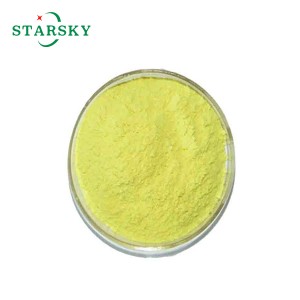Acetyl tributyl citrate CAS 77-90-7
Product name:Acetyl tributyl citrate/ATBC
CAS:77-90-7
MF:C20H34O8
Density:1.05 g/ml
Melting point:-59°C
Boiling point:327°C
Package:1 L/bottle, 25 L/drum, 200 L/drum
1.It is non-toxic plasticizer. It can be used as PVC, cellulose resin and synthetic rubber plasticizer.
2.It is used for non-toxic PVC granulation, food packaging containers, children's toy products, film, sheet, cellulose paint and other products.
3.It can also be used as stabilizer of polyvinylidene chloride.
1. Plasticizer in polymers: It is widely used in the production of flexible plastics, such as polyvinyl chloride (PVC), to enhance its flexibility and durability.
2. Food Packaging: Due to its low toxicity, acetyl tributyl citrate is used in food packaging materials to improve their flexibility and performance.
3. Cosmetics and Personal Care Products: It is often added as a plasticizer to the formulation of cosmetics, lotions and creams to improve texture and application properties.
4.Coatings and Adhesives: Can be used in various coatings and adhesives to enhance their flexibility and bonding properties.
5. Pharmaceuticals: In some cases, it can be used as an excipient in drug formulations to improve the properties of the final product.
It is insoluble in water, soluble in most organic solvents. It is compatible with a variety of cellulose, vinyl resin, chlorinated rubber, etc.
Stored at a dry, shady, ventilated place.
Acetyl tributyl citrate should be stored in a cool, dry place away from direct sunlight and heat. It is best stored in a sealed container to prevent contamination and evaporation. It should also be stored in a well-ventilated area away from incompatible materials.

General advice
Consult a doctor. Show this safety data sheet to the doctor on site.
Inhale
If inhaled, move the patient to fresh air. If breathing stops, give artificial respiration. Consult a doctor.
skin contact
Rinse with soap and plenty of water. Consult a doctor.
eye contact
Rinse thoroughly with plenty of water for at least 15 minutes and consult a doctor.
Ingestion
Never give anything by mouth to an unconscious person. Rinse your mouth with water. Consult a doctor.
1. Regulatory Compliance: Ensure compliance with local, national and international regulations regarding the transportation of chemicals. Check if it is classified as hazardous goods.
2. Packaging: Use appropriate packaging materials that are compatible with acetyl tributyl citrate. The container should be airtight and made of materials that do not react with the substance.
3. Label: Clearly label containers with the correct chemical name, hazard symbol (if applicable), and handling instructions. Include all necessary Safety Data Sheets (SDS) when shipping.
4. Temperature Control: If necessary, ensure that shipping conditions maintain a stable temperature to prevent product deterioration.
5. Avoid leaks: Take precautions to prevent leaks during transport. This may include using secondary containment or absorbent materials in the event of a leak.
6. Training: Ensure that personnel involved in the transportation process are trained in chemical handling and are aware of the potential hazards associated with acetyl tributyl citrate.
7. Emergency Procedures: Develop emergency procedures for the event of an incident during transportation, including contact information for emergency response.

Acetyl tributyl citrate is generally considered to have low toxicity and is not considered harmful to humans under normal conditions of use. It is often used as a plasticizer in food packaging and cosmetics, which suggests that it is relatively safe in these applications. However, like any chemical, it poses risks if ingested, inhaled, or comes into contact with the skin in large quantities.
Here are some safety considerations:
1. SKIN CONTACT: Prolonged or repeated skin contact may cause irritation to some individuals. It is recommended to wear protective gloves when handling this material.
2. Inhalation: Avoid breathing vapor or mist as it may cause respiratory irritation.
3. Ingestion: Ingestion of acetyl tributyl citrate may be harmful and should be avoided. If ingested, seek medical attention.
4. Safety Data Sheet (SDS): Always refer to the Safety Data Sheet for specific information on hazards, handling and first aid measures.
5. Regulatory Status: Please check local regulations and guidelines for any specific safety classifications or recommendations.











